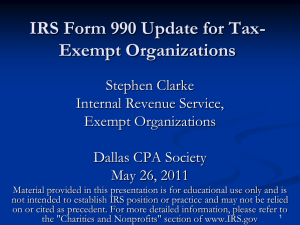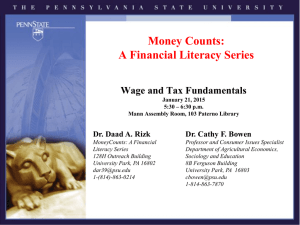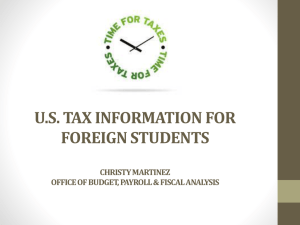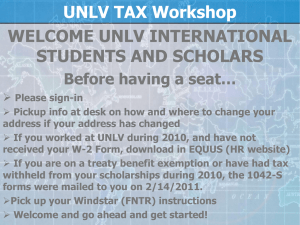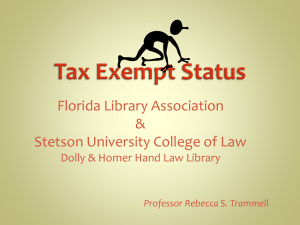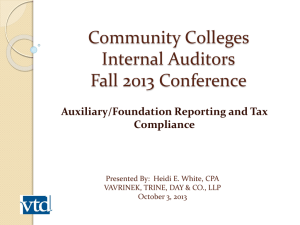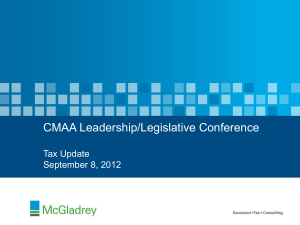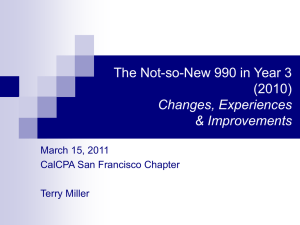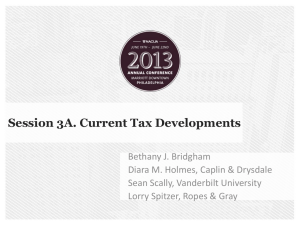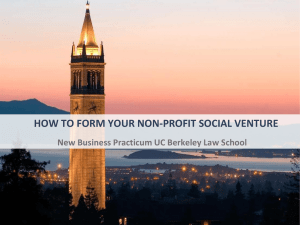Exempt
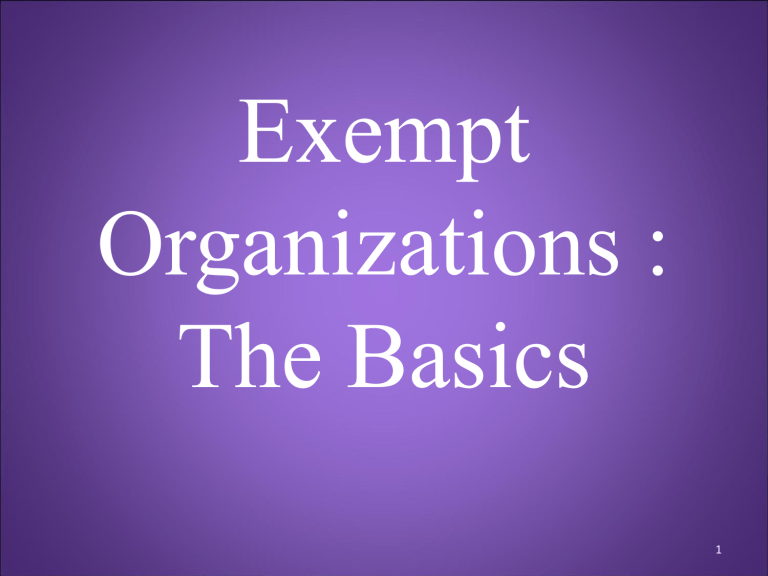
Exempt
Organizations :
The Basics
1
Edmund R. Sledzik
Attorney/Tax Practitioner/Associate EA
1704 Shagbark Circle
Reston, VA 20190-4437
Home/Work: 703-471-7584
Fax: 703-471-1537
ERSledzik@aol.com
2
Introduction:
A.Abe Lincoln –
“A good lawyer knows what to do. It is not how long it takes you to do a project that makes you successful. It is what you know.
”
3
B. How I started. –
My first experience with an exempt organization was in
1972 when I received a 501(c)(7) for my dog club.
I attended my first audit in 1994. I learned that there were a lot of organizations out there that needed Tax
Exempt Help and that there weren’t many providers that could actually provide them with that service.
We have helped around 400 organizations get tax exemptions since then, and we currently file about
147 Form 990’s
4
We will focus on (C) 3, 4, and 7 Exempt Organizations, then give you some insight on what we experience with the IRS and clients, and end up answering your questions
A.
Applications
B.
Filing Forms 990 and 990-T,
990 EZ and 990-N
C.
Keeping the books
D.
Giving advice during the year
5
Applications:
A. Form 1024 – All sections except (c)(3)
1. Usually 6 pages long. Focuses on what activities make the organization exempt.
2. Write up on page 2 is important. It is used to persuade the agent that the organization is within the rules for an exemption. I usually ask the organization to tell the IRS what they will be doing now, in the near future, and in the far future. How much time will be spent on each project; and how much will it cost.
6
3. The IRS wants three years of Profit & Loss. If your club is new or it did not keep good records, you are allowed to project your clubs income and expenses for the next two years.
4. You will also have to file a Form 2848 – Power of
Attorney and Declaration of Representative with the IRS.
5. For 2010 the IRS Application fees for clubs who are expected to make less than $ 10,000. on average for three consecutive years is $ 400. For clubs who are expected to make more than $ 10,000. on average for three consecutive years it is $ 850. The IRS will change this fee without notice.
7
6. We send the application to the IRS in Covington,
Kentucky by UPS so that we can track the package.
The same day we send out the application to the IRS we also send out your copy of the application to you.
This lets you know that we sent it into the IRS.
7. The IRS will send your clubs Authorized Official and your Authorized Representative (Me) notice that they received the application generally within four to five weeks. During the main tax season this could take longer.
8
8. Kentucky assigns the cases to among 40 of its agents.
If there is an overflow, then the application goes out to the field. This could be a problem. The field is not up to date and they are not experienced. They tend to question the applications. The persons in Kentucky know what is good and what is bad for they get the applications all the time.
9. One person in San Francisco gave me a hard time on a dog club ruling because believed that dog clubs should not be exempt. Another would not give a ruling even when I showed him five rulings I had just received. He did not care if I had a thousand. He would stand his ground and say no.
9
10. If you receive an exemption. Your exemption will go back to the date of incorporation or the date that the trust was set up. This means that your club can get a refund from the IRS and most states if you filed a
Form 1120 and had to pay taxes.
11. The IRS has expanded the types of organizations you can form to be exempt. It recognizes a corporation, a trust, an association and an LLC. I usually incorporate the main organization. Trusts are easier to get done and they do not have to have yearly meetings or pay a state a fee. I do not like associations because they do not last. I have only seen one LLC, and it was formed under special circumstances to limit liabilities.
10
12. When you incorporate or create a trust etc. there are paragraphs that must be contained in the Constitution, by-laws, the trust or the LLC. There must be a dissolution clause giving the assets to a charity. There must be a purpose clause. There must be a statement that the members or the organization cannot use the organization’s funds for personal matters.
13. Form 8718 – User Fee For Exempt Organization
Determination Letter Request.
11
B. Form 1023 -- 501(c)(3) Organizations
1. This form is for Section 501 (C)(3) organizations where donations to the organization by the donors are deductible on a person's tax return. It is harder to get a ruling here. We have experienced situations where a club was turned down and had no trouble getting a
(C)(4) or (C) (7).
2. The form is 29 pages long. What pages to use?
Depends on what the exempt organization will be doing.
12
3. Normally pages 1 to 12 will be made out. Page 12 must be signed. Page 11 is no longer need, it allowed the IRS to look at your client in five years. It is the public charity versus private foundation issue. What is the difference between a foundation and a public charity? The public charity can accumulate its income from year to year. A foundation must distribute its income yearly or pay an excise tax. White elephant problem involving a foundation. The IRS no longer needs this.
4. What is deductible? Discussion of raffles, auctions and cash gifts. Record keeping requirements.
13
5. Need to have 35% of donations coming from dues, activities, and public.
6. Lobbying – 20% rule
7. Dues not normally deductible. $100,000 rule – statement on dues.
8. How to lose the exemption
9. Once they lose the exemption they cannot go anywhere else.
14
C. Form 1024 - (C) (4)
1. No deduction on individual’s tax return
2. Can lobby
3. Dividends and interest not taxed
4. Do not have to report on Form 990 if gross is less than $25,000. These organizations now use Form
990-N yearly, electronically. It contains the organization’s name, its address, the key officer’s name and a statement that the organization is still in existence. The three year rule ended this year.
Organization’s who did not file may lose their exemption if did not file a 990-N.
15
5. Problems arise because the IRS was caught by surprise when Congress created this new rule.
They do not have a list of exempt organizations that go back before the 90’s. The program broke down.
So some Clubs had to prove that they received an exemption. Has anyone been looking for an exemption paper you got in 1972? It happened to my club, and we found it.
16
D. Social Clubs: (C) (7)
1. IRS’s idea of a typical social club.
2. Must pay taxes on interest and dividends.
3. Form 990-T - $1,000 exclusion
4. Set aside rule.
5. 15%/35% test – auditing social clubs to take away their exemption.
17
Questions You May
Have Asked Me…
If We Had Time
18
1. What happens if we miss a filing date or an extension date?
Answer: You are fined $20 a day for being late up to a maximum amount based on your gross income.
19
2. Is there any way out of this fine?
Answer: Yes. You can ask for an abatement of the penalty. The IRS is willing to listen to your story. The good ones are sickness, a person resigning and getting even, you found out that the last treasurer did not file and you voluntarily filed before the IRS found you.
You attended my lecture and found out that you had to file and you did so. I have had embezzlement situations, death, stokes, club disciplinary actions etc. I also had a situation where the treasurer thought he had two more months to file, because he was misinformed on the ending year date. If you do not ask, you get nothing. It is better
3. Are there any unforeseen situations we should be aware of?
Answer: Yes. Clubs that gross more than $100,000 a year are required to have the treasurer state on the dues notice that "The IRS has stated that dues are not usually deductible."
There is a $1,000 fine for every year that you do not do this.
21
4. Are some states harder than others in policing exempt organizations?
Answer: Yes. California is the worst. You must get a ruling from them that you are exempt as well as a ruling from the IRS. They do not accept the IRS ruling. Some state do not require you to collect sales tax if you are exempt. This is important to you the parent clubs because many of you have roaming National Specialties. I have available a book from CCH that comes out yearly. It costs about $350. every year.
But it contains every state's rules on sales
22
taxes and whether if you are a (C)(3) organization you have to register and pay to solicit donations in that state. Then states are different. In Virginia if you come in for a show, all you have to do is ask them and they will waive the sales tax. Florida and
California will not waive. Treasure getting even with a club turned the club in for not filing sales tax for the last 5 National
Specialties. Three states waived it, and two did not. Yes it was Florida and California.
23
5. In this regard do we have to file in our state of organization a tax return?
Answer: It depends on the State. Illinois, Indiana, and
California require you to file a return. They have special forms. California has Form 199 for exempt organizations. New York has a form for (C)(3) organizations and it charges a fee annually. Many do not require a filing.
Delaware does not require one. The states where there are no individual income taxes do not require it. Those are Alaska, New
Hampshire, Washington, Nevada, Florida,
Texas, and I believe Tennessee. Many others do not care. If you are exempt federally
6. What does the IRS concentrate on in an audit of an exempt organization?
Answer: The IRS is trying to determine if you reported everything to it. Is the income amount correct?
Are the expenses correct? What kind of records do you keep? Quicken or Quick
Books? Do you have bills and receipts. They do not get involved much in balance sheets.
They know that usually volunteers are the treasurers and most are not being paid. Notice that on Form 990-EZ there is a place for adjustments to the balance sheet.
25
7. What do we do with Form 1099? What if a person refuses to give us their social security number?
Answer: You give a Form 1099 to any individual or partnership that you gave $600 or more to during the calendar year of January to
December. If you hire someone more than once, and the total of both goes over $600, you are supposed to give a Form 1099 by
January 31, of the following year. We provide this service to our dog clients. If the person itemizes expenses and has most of the
26
expenses available such as ticket, the expenses can be deducted before we look at the total.
If you fail to provide a Form 1099 when required, the IRS will penalize you at the rate of $50 per person. In addition you then become responsible for the social security taxes and medicare taxes, and they will collect them also. That amount is currently 15.4% of the gross amount. That means on a $1,000 bill you will pay the IRS $50 plus $154 for a total of
$204. If someone refuses without cause, then you treat that person as refusing to do what the
27
IRS requires, and you withhold backup withholding of $154. We had an audit where the agent wanted the club to show the hotel lodging receipts. They had none because most judges had not received their bill until the show. She was insistent. So we called the hotel where the judges were put up and the hotel faxed the billings. She still gave us a problem so we had to argue the Cohan rule and she conceded.
28
8. Do we need an audit yearly?
Answer: No. Not usually. You audit when there seems to be a problem with the books or you foresee a potential problem. I recommend that the books be looked at by a committee every third year or when a treasurer leaves. If there seems to be a problem, get a Lawyer to review the books or a CPA to audit the books.
A CPA usually will look at every entry and check the billing etc. A lawyer will usually spot check four to five months in a year. If nothing is found out of place, he or she will go to the next year and do the same. If
29
something is wrong then he or she will look at all 12 months , check bills, receipts and bank transactions. Both will look at charge accounts etc. It is unfair to audit books without giving the treasurer notice and time to get them together. There should be an understanding up front that the books will be audited within a certain time after the treasurer taking office. A new treasurer should want the books of the past treasurer to be audited or reviewed so that she or he will not be responsible for past mistakes.
30
9. How do you account for stock on the tax return?
Answer: Stock on balance sheet that increase or decrease in value each year. Put it in at cost and . If not then you must tell the IRS of increases and decreases.
31
10. How do the new rules concerning 501(c)(3) donations affect us if we are a (c)(3)
Organization?
Answer: When you write a receipt to the donor you must add a statement to that receipt that says,
"The donor did not receive any consideration for this donation." If you did give something
(example: T-shirt, mulch, DVD's, Books,
Newsletters (PBS Items)), for this donation then your receipt should deduct the fair market value of the item(s) given to the donor.
32
IV. Conclusions
I spend 60 % of my time in this area, and my daughter, Keri, who is my partner, now works in this area with me. The government is looking for more money, and this area could be a gold mine for them. They thought that a lot of organizations were cheating, and not filing returns. We are awaiting a report on the results.
33
